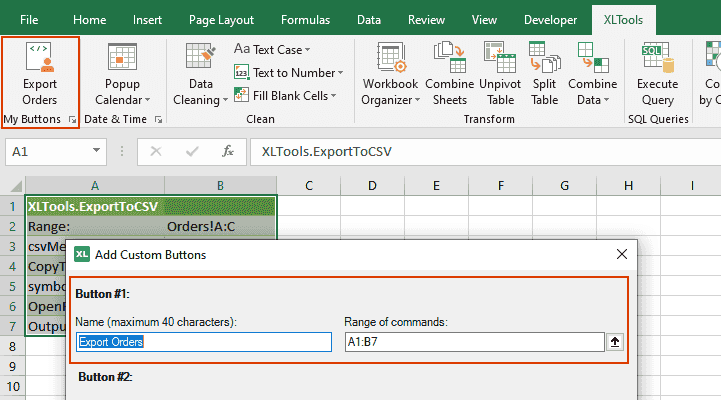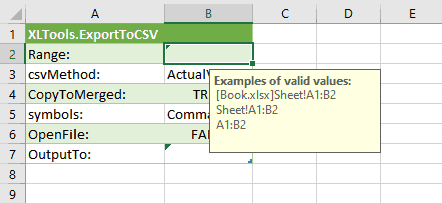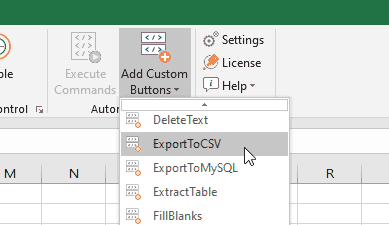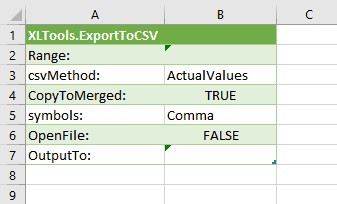ExportToCSV command: automatically convert Excel data to CSV

Before you begin, add the Automation tool to Excel
Automation is one of the 20+ features within XLTools Add-in for Excel. Works in Excel 2019, 2016, 2013, 2010, desktop Office 365.

Parameters and available options
Insert the command
Select a starting cell where to place the command, e.g. A1.
- Open XLTools tab
In the Automation group, open the drop-down list
Select ExportToCSV.
The automation table will be inserted on the worksheet.
![Insert the Export to CSV automation command in Excel]()
Fill out the automation table. All parameters and available attributes are listed below.
Range:
Specifies which data range should be processed.
- Required parameter, cannot be blank
| Options | Meaning |
|---|---|
| A1:B2 | Range A1:B2 on the current worksheet |
| Sheet1!A1:B2 | Range A1:B2 on Sheet1 in the active workbook |
| Sheet1!A:C | Columns A:C on Sheet1 in the active workbook |
| Sheet1!1:3 | Rows 1:3 on Sheet1 in the active workbook |
| Sheet1! | Entire Sheet1 in the active workbook |
| Sheet1!Table1 | Table1 on Sheet1 in the active workbook, without table headers |
| Sheet1!Table1[Column1] | Column1 in Table1 on Sheet1 in the active workbook, without table headers |
| Sheet1!Table1[[Column1]:[Column3]] | Columns 1:3 in Table1 on Sheet1 in the active workbook, without table headers |
| Sheet1!Table1[#All] | Table1 on Sheet1 in the active workbook, including table headers |
| Sheet1!Table1[[#All],[Column1]] | Column1 in Table1 on Sheet1 in the active workbook, including table headers |
| Sheet1!Table1[[#All],[Column1]:[Column3]] | Columns 1:3 in Table1 on Sheet1 in the active workbook, including table headers |
| [Book1.xlsx]Sheet1!A1:B2 | Range A1:B2 on Sheet1 in the workbook Book1. Book1.xlsx must be located in the same destination as the automation file. |
| 'C:\Documents\[Book1.xlsx]Sheet1'!A1:B2 | Range A1:B2 on Sheet1 in the workbook Book1. Book1.xlsx must be located in the specified file path location. If this workbook is closed, it will be automatically opened to execute the operation. |
csvMethod:
Defines which format the values should be exported into the resulting CSV file.
- Required parameter, cannot be blank
| Options | Meaning |
|---|---|
| ActualValues | Export values in default format – as displayed in Excel formula bar. For example, 0.1, 3/12/2016, 40.00 |
| FormattedValues | Export values in the format that matches Excel formatting – as displayed in cells. For example, 10%, 12-Mar-2016, $40 |
CopyToMerged:
If your source Excel range contains merged cells, you can duplicate values from merged cells into the corresponding places of the resulting CSV text string.
- Optional parameter, you can remove it from the command
| Options | Meaning |
|---|---|
| TRUE | Values in merged cells in Excel will be duplicated in the resulting CSV file. Recommended if your Excel range has merged cells. |
| FALSE | Values in merged cells in Excel will not be duplicated in the resulting CSV file. Use if Excel range has no merged cells, otherwise CSV string will have blank values. |
| (none) | Same as FALSE |
symbols:
Defines a separator (delimiter) between values in the resulting CSV file.
- Required parameter, cannot be blank
| Options | Meaning |
|---|---|
| Comma | Use comma (,) as a separator. This is the most common option for CSV files. |
| Semicolon | Use semicolon (;) as a separator |
| Tab | Use tab (tabulation symbol) as a separator |
| Pipe | Use pipe (|) as a separator. Also called a vertical bar or a vertical line. |
OpenFile:
Defines whether to open the resulting CSV file after the command is executed.
- Optional parameter, you can remove it from the command
| Options | Meaning |
|---|---|
| TRUE | Open the resulting CSV file after the command is executed. You can immediately review the results. |
| FALSE | Don’t open the resulting CSV file after the command is executed |
| (none) | Same as FALSE |
OutputTo:
Specifies how to name the resulting CSV file and where to save it on your computer.
- Required parameter, cannot be blank
- The length of the text string cannot exceed 250 characters
| Options | Meaning |
|---|---|
| Result.csv | Name the resulting file Result.csv. The file will be saved to the same destination as the automation file. If the workbook with automation commands is not yet saved, the default location for output is the “My Documents” folder of the current user. |
| C:\Documents\Result.csv | Name the resulting file Result.csv and save it to the specified destination on the computer |
Step-by-step example [download]
1. Insert the ExportToCSV command
Open the Excel file with the source data you want to export to CSV. In our example, the spreadsheet Orders.xlsx contains the worksheet "Orders" with a table of recent product orders.
On the sheet AUTO, select a starting cell where to place the command, e.g. A1.
- Open XLTools tab
In the Automation group, open the drop-down list
Select ExportToCSV.
![Step 1: select the automation command from XLTools ribbon]()
Done! The table with the automation command is added on the worksheet.
![Step 1: the automation command is added on the worksheet]()
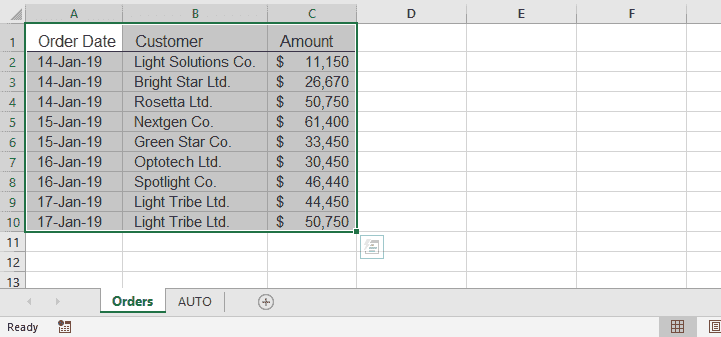
2. Specify parameters of the ExportToCSV command
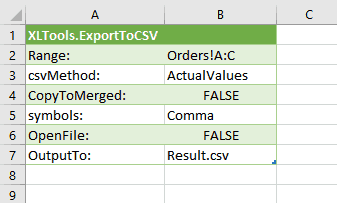
What each line in this command reads:
- Range: take the range A:С on the sheet Orders. This is the source range to export to CSV.
- csvMethod: choose ActualValues, so that the values in the table are exported to CSV in default format, just as they are displayed in Excel formula bar.
- CopyToMerged: select FALSE, since there are no merged cells in the source range.
- symbols: choose comma as a delimiter between values in the resulting CSV file.
- OpenFile: choose FALSE, not to open the resulting file after the command is executed.
- OutputTo: name the resulting file "Result.csv". It will be saved to the same folder as the file with automation commands.
3. Execute the command and review the resulting CSV file
- Select the table with the command
In the Automation group, click the Execute Commands button.
- Wait until the processing is complete
Done! Find the resulting file "Result.csv" in the same folder as the source Excel workbook with commands.
See that:
- Values are exported in the default format
- Comma is used as a delimiter
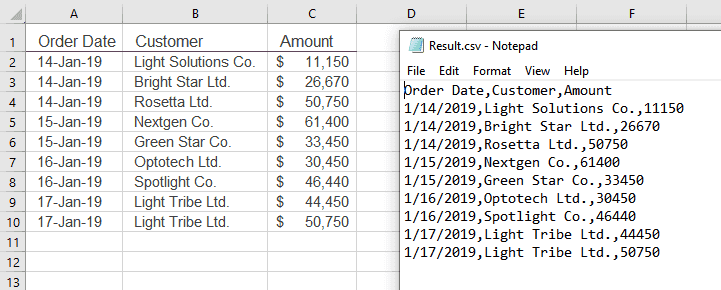
4. Assign a custom button to execute the command
If you have to run the command over and over again, add a custom button on the ribbon. So that next time you execute the command in just a click.
- In the Automation group, click Add Custom Buttons
A window will open.
- Name the button, e.g. "Export Orders"
Specify the range of the ExportToCSV command
Click Save.
- Done! Your custom button will appear on XLTools tab. Now the command will be executed when you click the button.
